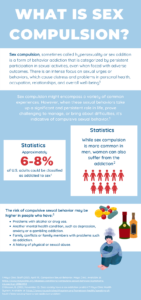Statistics on Sex Compulsion in the United States
Sex compulsion is a behavioral addiction that is categorized by persistent participation in sexual activities, even when faced with adverse outcomes resulting from these actions. This leads to emotional distress and multifaceted detriments encompassing personal health, occupation, relationships, and overall well-being.1 This mirrors the patterns observed in substance use and impulse control disorders.2
Sex compulsion behavior might encompass a variety of common experiences. However, when these sexual behaviors take up a significant and persistent role in life, prove challenging to manage, or bring about difficulties, it’s indicative of compulsive sexual behavior. Through treatment and self-help, you can acquire skills to effectively manage and address compulsive sexual behavior.1
From a psychological standpoint, these sexual behaviors often serve as a means to evade emotional or physical distress, or as a mechanism for managing the challenges of life. Paradoxically, these sexual behaviors evolve into the primary coping strategy, initiating a cycle of escalating issues and heightened feelings of desperation, shame, and fixation.2
- Although 6% to 8% of U.S. adults (24 million) may be classified as addicted to sex, there is still more research needed in this area.3
- While sex compulsion is more common in men, women can also suffer from the addiciton.3
The risk of compulsive sexual behavior may be higher in people who have1:
- Problems with alcohol or drug use.
- Another mental health condition, such as depression, anxiety or a gambling addiction.
- Family conflicts or family members with problems such as addiction.
- A history of physical or sexual abuse.
Strict and rigorous clinical criteria is needed to be met for evaluating sex compulsion as a disorder in individuals and for most clinicians, the diagnosis is reserved for those who engage in consensual sex and is not used for those who engage in sexual crimes4.
For more information, please visit: /http://id.who.int/icd/entity/1630268048
1Mayo Clinic Staff (2023, April 19). Compulsive Sexual Behavior. Mayo Clinic. Available at: https://www.mayoclinic.org/diseases-conditions/compulsive-sexual-behavior/symptoms-causes/syc-20360434.
2Fong T. W. (2006). Understanding and managing compulsive sexual behaviors. Psychiatry (Edgmont (Pa. : Township)), 3(11), 51–58.
3Gleeson, B. (2022, November 2). Does society have a sex addiction problem? Mayo Clinic Health System. Available at: https://www.mayoclinichealthsystem.org/hometown-health/speaking-of-health/does-society-have-a-sex-addiction-problem.
4 Rosenberg, K.P. (2022, June 27). Pandemic Revealed Unique Aspects of Sexual Addictions. Psychiatric News. DOI: 10.1176.appi.pm.2022.07.7.28




